How do you celebrate the people working for you in different locations and time zones?
If you’re managing remote employees, shoutouts that used to happen in staff meetings now happen in virtual huddles. Instead of bringing donuts to the office, you might give everyone a gift card for coffee. Teams that reach their targets get a bonus or unique gift.
Conventional wisdom says these strategies should help with remote employee engagement. Unfortunately, human behavior rarely follows conventional wisdom.
Employee recognition is no different.
Creating a culture of recognition and boosting remote employee engagement means breaking with conventional wisdom in one important way: equal treatment can make recognition ineffective.
To get recognition right, you must first understand the individual personalities who make up your team and what motivates them.
Only then can you foster a strong remote work culture that celebrates exceptional effort.
We’re here to help you do that in a fair, sustainable, transparent, and effective way.

Is remote employee engagement impossible?
Although remote work has many upsides for organizations and employees, there are challenges. Namely, remote employees report experiencing disconnection from company culture, isolation, and a lack of purpose.
Gallup’s research from 2023 found that exclusively remote workers felt increasingly disconnected from their company’s purpose.
Less than one-third (28%) of remote employees agreed that “The mission or purpose of my company makes me feel my job is important,” down 8% since 2020.
That’s compared to 33% of on-site (but remote-capable) workers and 35% of hybrid employees.
This decline follows the trend of employee engagement, people knowing what’s expected at work, and employees receiving recognition at least weekly. All these signals declined since 2020, according to Gallup’s long-term analysis.
Interestingly, they’re the same reasons outgoing employees gave at the height of the Great Resignation.
One McKinsey study from January 2022 found that “More than half of employees who left their job in the past six months did not feel valued by their organization (54%) or manager (52%), or they lacked a sense of belonging (51%).”
If you’re making intentional efforts to recognize and reward your team, then these insights may not be new to you.
But they’re still worth your attention as a team or organizational leader. Counteracting the unintentional consequences of remote work requires intentional effort.
Effort in the form of tailored remote employee recognition strategies.
Employee recognition benefits everyone
We know instinctively that praise is better than punishment. But just how much better is it?
A lot, it turns out. When organizations get recognition right, the benefits even reach outcomes that are tricky to influence when managing remote employees, like connection to culture, absenteeism and safety.
Two Gallup studies looking at the power of recognition, one in 2022 and a follow-up in 2023, saw significant differences in organizations that prioritized meaningful recognition. Employees who felt recognized were:
- 3.7x more likely to be engaged in their work
- 68% less likely to experience burnout symptoms
- 9% more productive on average
- 22% less likely to be involved in safety incidents
- 55% less likely to be actively job searching
- 22% less likely to be absent from work
This backs up our understanding of workplace wellbeing, that engaged employees are healthier, more productive and more valuable.
Seven in 10 employees who strongly agree that recognition is an important part of their company culture also agree that they feel connected to that culture.
Getting recognition wrong can be costly
Failing to recognize employees’ efforts in meaningful ways will only deepen their dissatisfaction until they disengage, burn out or quit. None of those are a good outcome.
- Every burned-out employee costs their company €23,677 ($24,500).
- Unmotivated employees drain $7.8 trillion from the global economy.
- Replacing an employee costs 33% to 200% of their salary.
This shouldn’t overshadow the cost to employees’ health and wellbeing. Employees who lack meaningful recognition suffer stress, emotional strain and resulting health issues.
When more than 8 in 10 employees (82%) experience regular burnout symptoms, recognition looks like an effective countermeasure to a widespread and worrying problem.
A quick sidenote on remote employee recognition
We need to say one thing before going further. Whatever you do to recognize and engage remote employees, you’ve earned our praise for doing it. Leaders who prioritize praise already understand the value of recognition. From here, it’s just a matter of fine-tuning your approach to motivate, retain and empower the people who will help your organization grow.
Our latest guide provides more insights into the challenges facing today’s teams and the importance of employee retention.
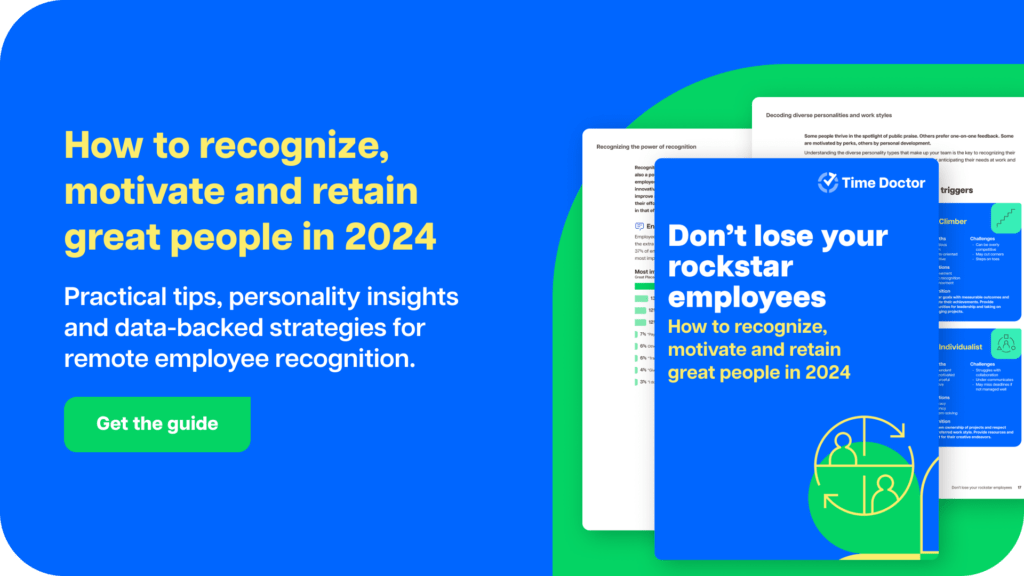
Finding balance: Remote employee engagement and a culture of recognition
So, we know that retaining a connection to culture remains a challenge when managing remote employees. We’ve also established that recognition is effective at counteracting employee disengagement.
Now, let’s revisit a point from earlier: equal recognition isn’t always effective.
If you have tried financial perks, free coffees, team celebrations and weekly shout outs, you might wonder why some employees perk up and others seem nonplussed.
It comes down to the different personalities in your team. In particular, their intrinsic motivations.
What is intrinsic motivation?
Intrinsic motivation is a person’s drive to engage in activities for their own sake. That is, for the satisfaction derived from doing them rather than for some external reward.
In the context of remote teams, intrinsic motivation refers to the internal desires that drive an employee’s engagement with their work.
There are three main elements of intrinsic motivation:
- Purpose: Feeling like their work contributes to a larger goal or makes a positive impact.
- Capability: The desire to learn, grow, and become an expert in their field.
- Autonomy: Having the freedom and control to manage their own work and make decisions.
Purpose and mastery are especially hard to grasp without face-to-face interactions and the frequent feedback of traditional offices. It’s also hard to feel in control of an overloaded schedule.
Although intrinsic motivators don’t need external rewards, they’re still fueled by feedback. Research in this space says that factors like cooperation, competition, recognition, control and overcoming challenges can increase intrinsic motivation.
For example, let’s say one of your team takes on the challenge of designing a new analytics dashboard. They’re motivated by mastery and see the purpose in the task.
However, when they finish the dashboard, the right person needs to recognize the accomplishment and its value to the organization. Otherwise, the employee will feel like their work was for nothing. They won’t volunteer to build the next dashboard.
Interestingly, research shows that external rewards can make an intrinsically motivated task less rewarding. This is called the “overjustification effect”. Essentially, the external reward replaces purpose, capability or autonomy as the motivating force, rendering the task less satisfying.
What this means for remote employee recognition
Understanding intrinsic motivations is essential for managing remote employees to their full potential.
It’s helpful in several ways:
- Allocating tasks to the right people.
- Designing the right kind of flexibility into work schedules (e.g. location, time or hierarchy flexibility).
- Providing meaningful recognition.
- Stoking the engine of self-motivation.
- Offering development pathways.
- Pairing employees with mentors.
- Identifying support needs and shortcomings.
- Achieving harmony in team dynamics.
- Replacing resource-draining external rewards with meaningful, frequent recognition.
Of course, none of these ideas apply universally. Intrinsic drivers, inspiring factors and motivation triggers will differ from one person to the next.
That’s as true for remote employee engagement as for sports teams, artists, students and your free-time hobbies. It’s why some people spend their weekends hiking up mountains and others with a good book.
The question is: Are you working with mountain climbers, readers, or another personality type?
10 personality types of remote employees and what engages them
Not all employees are engaged by the same things. Understanding your team’s different personality types and motivational factors is key to crafting a recognition strategy that engages everyone on their own terms.
We’ve outlined 10 personality types below to help you understand your colleagues’ traits.
However, a word to the wise first.
There are dozens of popular personality tests ranging from pseudo-scientific to purely speculative. Although the results can be enlightening, they are never 100% accurate or all-encompassing.
People are complex. Personalities are flexible.
Effective recognition requires a blended approach that prioritizes the individual’s needs over personality typecasts. By combining workday data, formal and informal feedback, and experimentation, you can hone recognition strategies that work to engage your team.
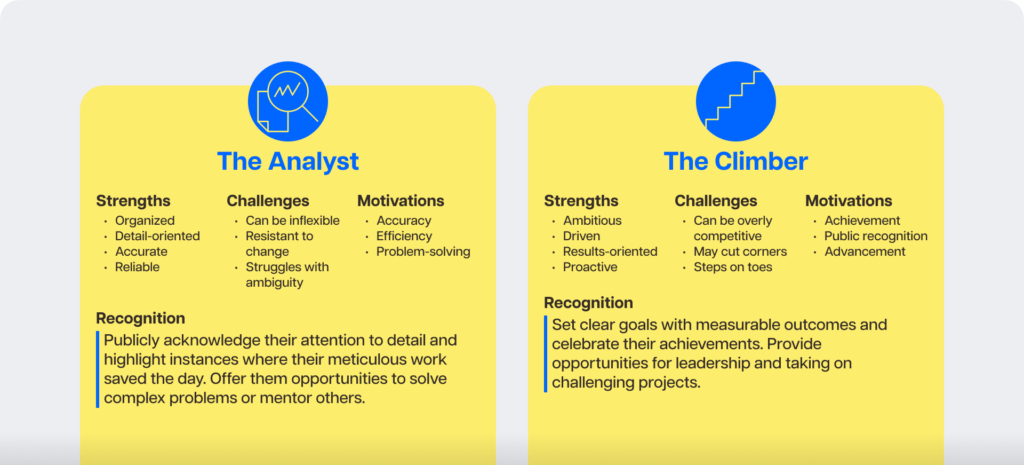
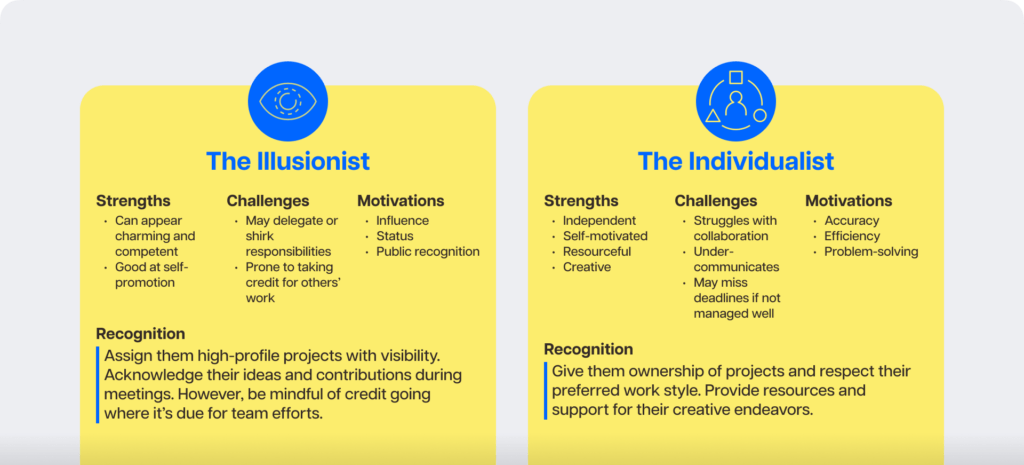
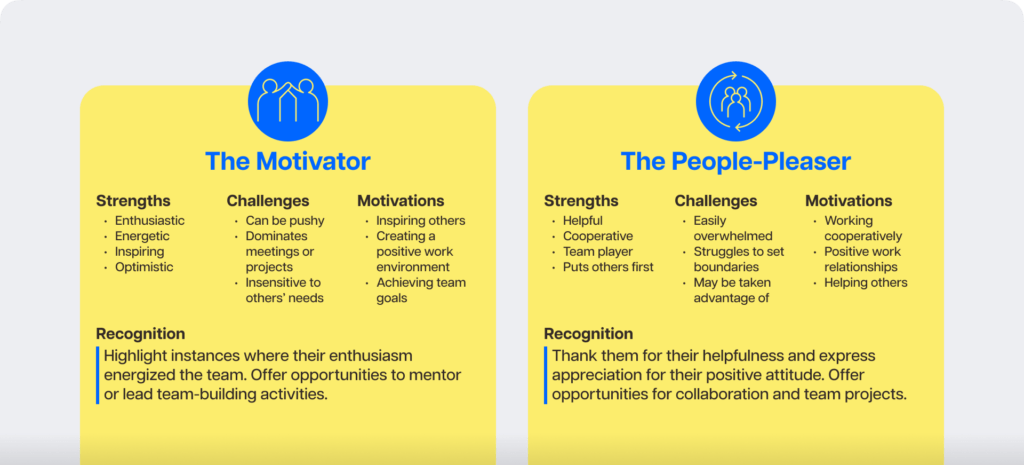
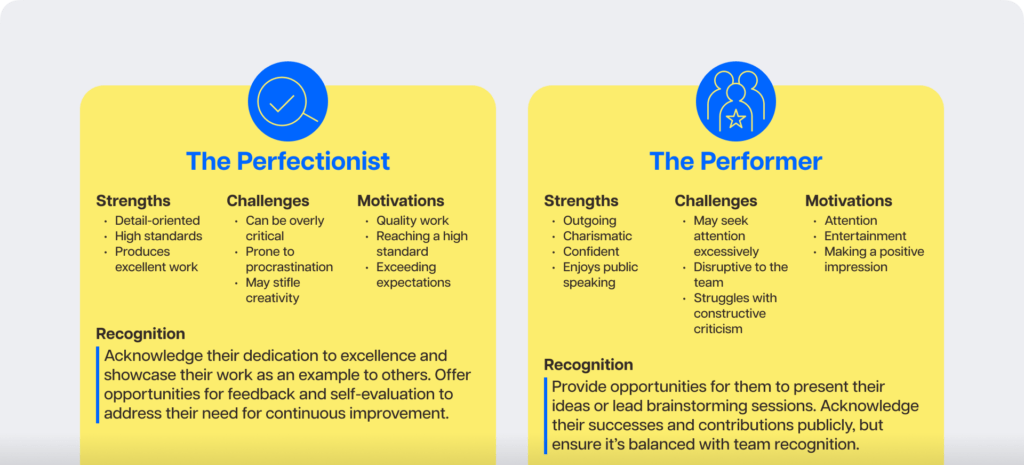
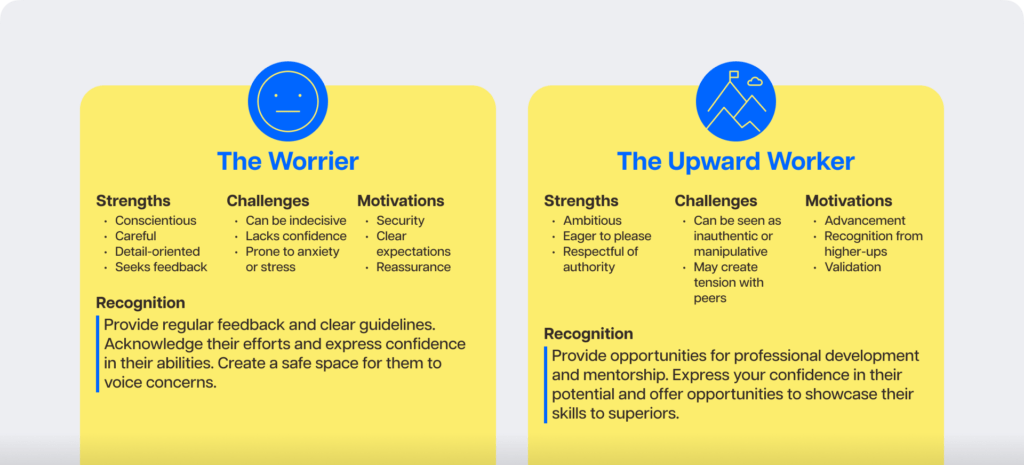
How do you know who’s who?
While these personality sketches offer a helpful framework, recognizing them in your team members can feel subjective. That leads to all kinds of problems with remote employee engagement, such as perceived favoritism, unbalanced workloads, and ineffective recognition strategies.
Workforce analytics tools like Time Doctor provide valuable data-driven insights to complement and contextualize your observations.
Reliable data on working habits, productivity levels, schedules, website usage and distractions enables managers to glean valuable information about each team member’s preferences and strengths.
Workforce analytics also removes bias from managing remote employees. Big personalities don’t overshadow quiet achievers; everyone can be recognized for who they are.
Using data to fine-tune remote employee engagement
By analyzing how employees spend their workday, you can tailor your approach, from setting the right challenges for the Ambitious Climber to providing the Independent Thinker with autonomy over their projects.
You can also track the outcomes in real-time to understand whether your efforts resonate.
Time Doctor provides deeper insight than time tracking. Employee engagement signals, including work-life balance trends, distracting website and app usage, breaks and schedule adherence give you a complete picture of wellbeing and performance.
Plus, with 60+ software integrations, you gain complete visibility over how your team and organization tackle projects.
This data-driven understanding enables managers to track each person’s contributions, recognize outstanding efforts, assess development and identify support needs.
It also empowers employees to self-manage flexible schedules and improve productivity. Employee-friendly dashboards provide endless fuel for intrinsic motivation.
When you put all these together, the outcome is a team that understands each other and works together better.
Bring it all together to create a culture of recognition
Personalized, genuine and frequent recognition is a powerful and underutilized motivator. In a time when finding and retaining good people is harder than ever, and reinvention is the only way to survive (let alone grow) as a business, companies can’t afford to let good people burn out or walk.
As a people leader managing remote employees, you must get recognition right.
We’ll finish off with some good news. It’s not entirely up to you as a manager.
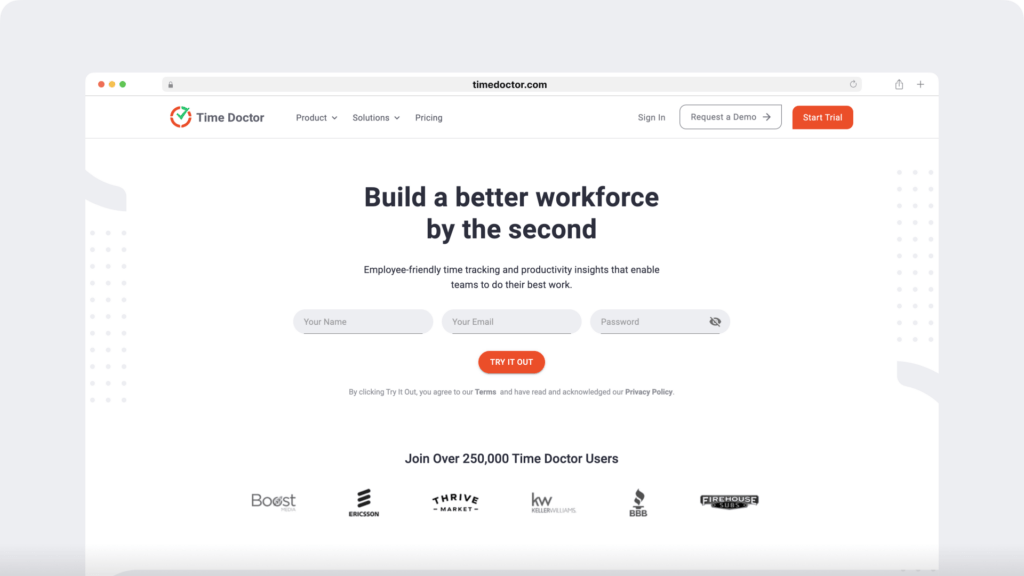
For one thing, Time Doctor’s reliable workday analytics tools give you complete visibility over your team’s working styles and engagement levels. Time Doctor is also a user-friendly solution to enable autonomy and a source of reliable workday data.
You also have your team to support you.
Truly effective recognition is ingrained in workplace culture. Think of it like an intrinsic motivator shared throughout your team.
You can inspire this by demonstrating healthy and fair recognition strategies, acknowledging team members who exhibit desirable behavior, and providing dedicated platforms for peer recognition.
The exact form that recognition and motivation take in your team will depend on the unique personalities that make it up, the goals those people share, and the direction your organization is heading in.
Whatever that looks like, Time Doctor is here to help.
Want to see the full range of flexible workforce analytics features and 60+ software integrations in action? View a demo of Time Doctor or start a free 14-day trial.
You’ll have the opportunity to see first-hand how employee-friendly workforce analytics can help to identify your team’s unique talents and create a culture of recognition.

Carlo Borja is the Content Marketing Manager of Time Doctor, a workforce analytics software for distributed teams. He is a remote work advocate, a father and a coffee junkie.


